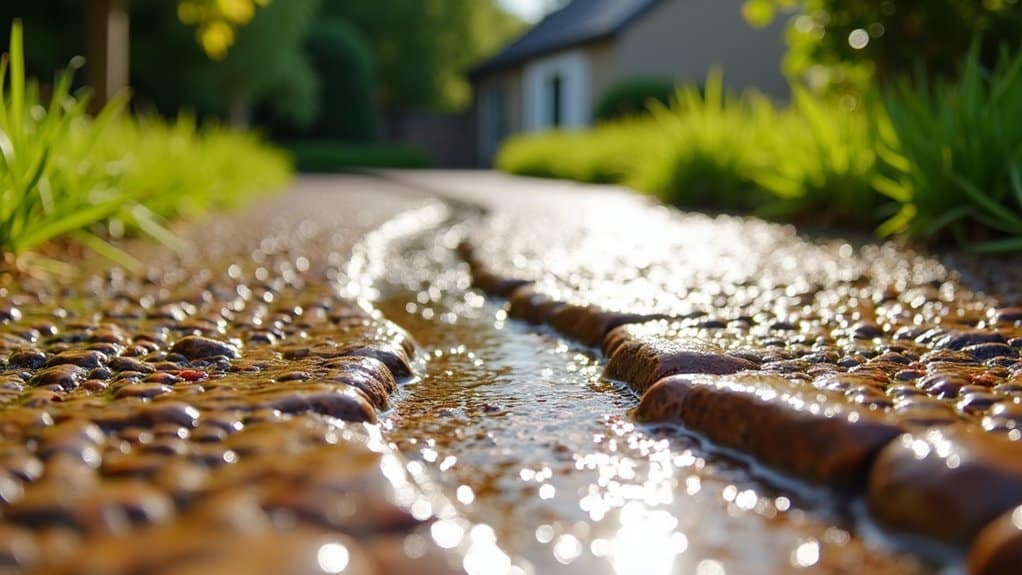Proper drainage for your resin-bound gravel driveway starts with choosing coarse, angular stones that allow water to pass through easily. Create a gradient of 1-2% to help water flow away naturally. Lay a solid sub-base using MOT Type 3 aggregate, ensuring it’s properly compacted. For extra protection against flooding, fit channel drains or soakaways – particularly useful in typical British weather. Think of it like a good raincoat: the right materials and design keep everything dry underneath. These steps will keep your driveway puddle-free and lasting longer.
Key Takeaways
Essential Steps for Drainage in Your Resin-Bound Gravel Drive
- Mix 1-3mm and 2-5mm aggregate for better stability and water flow through the resin surface – think of it like layering different-sized pebbles in a plant pot.
- Build your drive with a gentle slope of 1-2% (roughly 1cm drop per metre) so rainwater naturally runs off rather than pools.
- Lay MOT Type 3 sub-base at least 100mm deep – this crushed stone foundation works brilliantly for British weather conditions.
- Fit proper drainage channels and soakaways where your drive meets the house or garage. These act like gutters for your ground level.
- Check your driveway each season for blocked drains or dips where puddles form – sorting small issues early prevents bigger headaches later.
Understanding Resin-Bound Gravel Driveway Permeability

The permeability of resin-bound gravel driveways is crucial for both their function and eco-friendliness. Think of the system like a sponge – whilst the resin itself doesn’t let water through, it bonds the stones together in a way that leaves tiny channels for rainwater to pass through.
Much like choosing the right stones for a garden path, the type and size of gravel used makes a big difference. Larger, angular stones create better drainage spaces than smaller, round ones (similar to how large pebbles in a jar leave more gaps than sand would). This is because permeable driveway designs require gaps or pores for effective water infiltration. Additionally, resin bound surfaces with high permeability rates can facilitate effective water drainage and manage heavy rainfall.
Getting the installation right is vital – proper spreading and levelling ensure these drainage channels stay open. The surface needs proper time to set, typically 24 hours in dry conditions, to maintain these water-friendly pathways.
When done correctly, your driveway won’t just look smart – it’ll handle British weather brilliantly, preventing puddles and reducing flood risks to your property.
A well-installed resin-bound surface easily copes with our regular rainfall, making it a sensible choice for UK homes. Plus, it meets planning requirements for sustainable drainage systems (SuDS), which is increasingly important for British homeowners.
Importance of Sub-base Permeability and Preparation
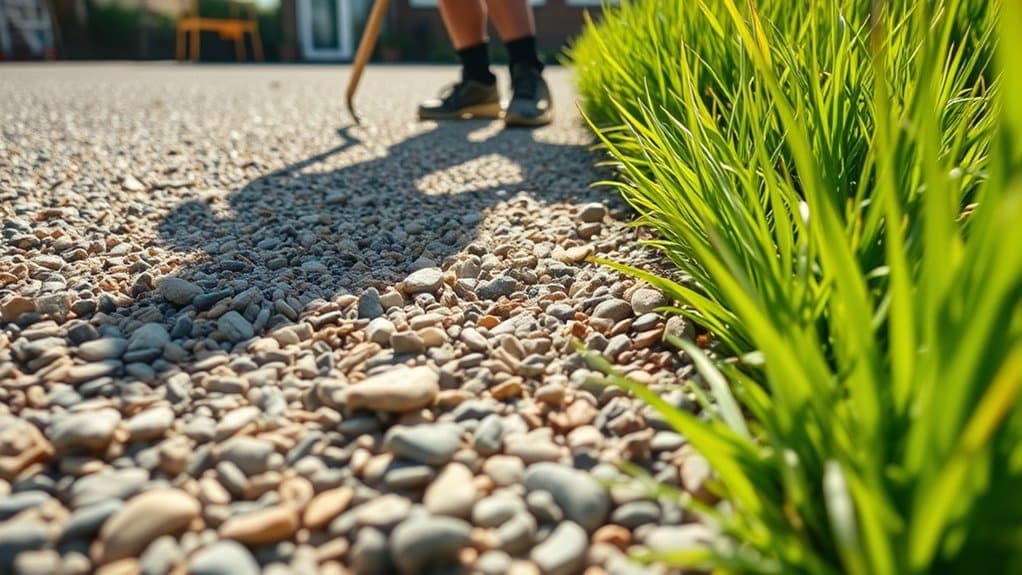
The success of a resin-bound gravel driveway depends heavily on its sub-base and proper installation. A suitable sub-base, such as MOT type 3 or open-graded tarmac, ensures water drains effectively through the resin layer, preventing puddles and meeting SuDS requirements. Think of the sub-base as the driveway’s foundation – it must be properly compacted to stop any sagging or cracking later on. For best results, the sub-base should be completely level and thick enough – at least 100mm for tarmac bases. Additionally, a resin-bound surface is compliant with SuDs regulations, which enhances water drainage and reduces surface runoff. Proper edge restraints are also critical to prevent shifting, ensuring the stability of the entire driveway. Regular checks and maintenance keep the drainage working properly and your driveway looking smart. Getting these basics right at the start will save headaches down the line and ensure your investment lasts.
Assessing Supplemental Drainage Options
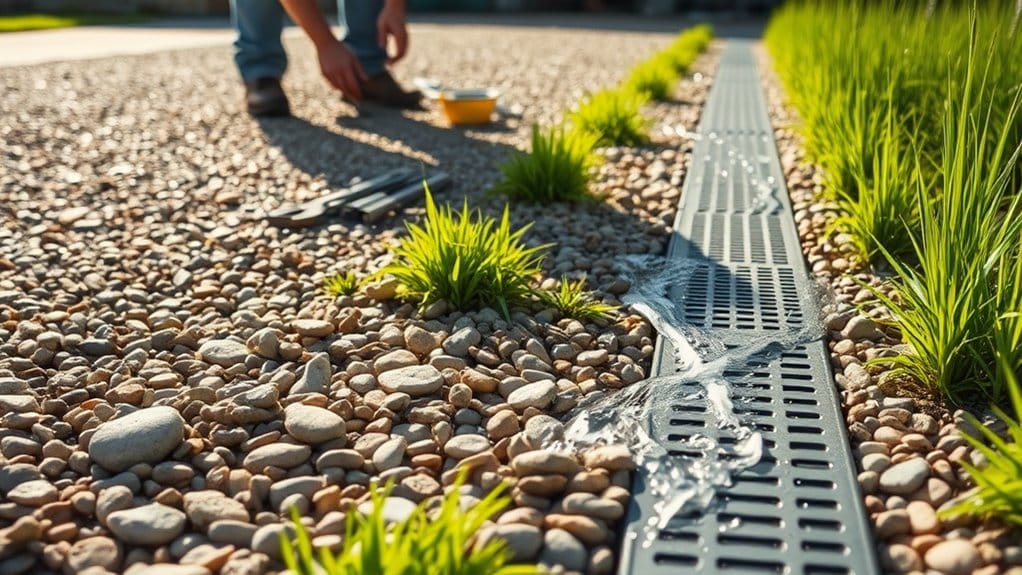
Effective ways to boost drainage on your resin-bound gravel driveway:
Channel drainage systems are essential kit for managing surface water. These modular units sit flush with your driveway and whisk away standing water before it becomes a problem. They are particularly handy for British weather, where regular rainfall is the norm. Additionally, they prevent total coverage with impervious materials, ensuring porous areas are maintained. This is crucial for supporting Sustainable Urban Drainage Systems that effectively handle stormwater management.
Proper sloping and grading make a massive difference – even a slight gradient helps water flow naturally off your drive. For tough spots, installing permeable edge trenches or soakaways gives excess water somewhere to go, letting it seep safely into the ground.
Connect your channel drains to underground pipes to move water well away from your property. This proves invaluable during winter months, preventing dangerous ice patches from forming. Regular checks and maintenance of these drainage solutions keep everything working properly.
A quick monthly inspection, especially after heavy rain, helps spot any issues early on.
Regulatory and Environmental Considerations
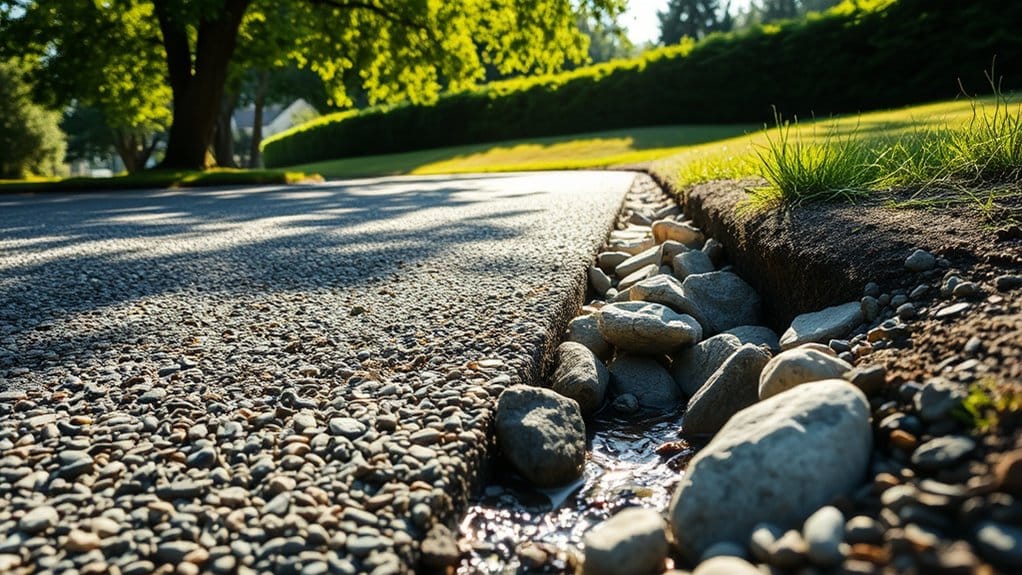
Regulatory and environmental rules for resin-bound gravel driveways in the UK are straightforward but important to follow.
Your driveway must comply with SUDS regulations, which help prevent flooding and manage rainwater runoff – a common issue in British weather.
A properly installed resin driveway naturally helps with drainage by letting water seep through to the ground below, unlike traditional concrete or tarmac.
Think of it as a giant sponge that helps prevent puddles and reduces pressure on local drains during heavy rainfall.
You’ll need to check with your local council about planning permission, particularly if you’re adding special drainage features.
Most standard installations don’t require it, but it’s worth confirming to avoid headaches later.
The key things to sort out are:
- Testing ground drainage before installation
- Keeping proper documentation of the work
- Using permeable materials that meet UK standards
- Setting up a basic maintenance schedule
Getting these basics right means you’ll have a driveway that’s both legal and environmentally sound, while helping to protect local wildlife and reduce urban flooding.
Installation Best Practices for Effective Drainage

The proper installation of a resin-bound gravel driveway hinges on two key factors: the right aggregate size and correct slope grading.
Select permeable aggregates that let rainwater seep through whilst keeping the surface stable. A decent slope of about 1:60 helps water run off properly, which stops puddles forming and keeps your driveway in top nick longer.
Think of it like laying bathroom tiles – you’d never want them completely flat, as the water needs somewhere to go.
Aggregate Size Selection
Selecting the right aggregate size is crucial for your resin-bound gravel driveway’s drainage. A blend of 1-3mm and 2-5mm stones works best, much like layering different-sized pebbles in a plant pot.
The larger stones create gaps for water to flow through, whilst smaller ones fill spaces to maintain stability – think of it as nature’s jigsaw puzzle.
For best results, mix 75kg of 2-5mm aggregate with 25kg of 1-3mm aggregate, using about 7% resin. This mix ensures your driveway stays porous, meeting UK sustainable drainage requirements whilst looking smart and uniform.
The combination provides excellent drainage during typical British weather and prevents puddles from forming, making it a practical choice for UK homes.
Proper Slope Grading
Proper slope grading plays a vital role in draining water from resin-bound gravel driveways effectively. The slope must be at least 1-2% to ensure water flows away from buildings and other structures.
To get this right, you’ll need precise gradient measurements and proper base preparation. Start by thoroughly compacting the base layer and choosing permeable materials that allow water to drain through.
Steeper slopes need extra care – they’re more prone to erosion and require additional stabilisation measures.
For the best results, pair good slope grading with suitable drainage systems and choose a resin mixture that offers anti-slip properties. This combination will keep your driveway safe, functional and looking smart throughout the British weather.
Maintenance Tips for Longevity and Efficiency

Regular upkeep of your resin-bound driveway keeps it in top condition and helps avoid costly repairs.
Sweep away leaves and debris at least monthly, especially during autumn when fallen leaves can clog drainage channels.
Check the drains after heavy rainfall to spot any blockages, and look out for cracks or dips in the surface – early signs of possible sub-base problems.
A quick monthly inspection, much like checking your car’s tyre pressure, helps catch issues before they become serious.
Regular Debris Removal
Regular sweeping keeps your resin-bound gravel driveway in top condition and prevents drainage problems.
Use a stiff broom once a week to clear leaves, dirt and dust. For bigger driveways, a leaf blower works well for light debris, whilst a rake handles stones and twigs effectively.
Give the surface a quick rinse with water after sweeping to wash away any leftover bits. Deal with stains straight away to stop moss from taking hold.
During autumn, you’ll need to sweep more often to tackle fallen leaves. This simple routine will keep your driveway looking smart and working properly throughout the year.
Inspect Drainage Channels
Regular checks of drainage channels are vital for a resin-bound gravel driveway’s performance and lifespan.
Check the slope carefully – it should drop 1-2% towards the outlets to stop water from pooling. A laser level helps ensure the surface slopes correctly across the whole driveway.
Look at how channels sit against edges and dips, and watch how water flows during rain to spot problem areas.
Make sure outlets work properly by removing leaves and debris, and check that grates aren’t damaged.
Keep notes of any changes from the original setup and when you’ve done inspections.
Taking these steps helps maintain proper drainage and protects your investment.
Monitor Sub-base Condition
Regular checks of your driveway’s sub-base are crucial for its long-term stability. Look out for any dips, uneven areas or sinking spots, as these often signal underlying problems.
Using MOT Type 1 aggregate creates a robust foundation, whilst proper compaction ensures effective drainage. Watch for water pooling or soft patches after rain – these are tell-tale signs of drainage issues.
Keep nearby plants and soil graded away from the driveway to prevent water damage. Spot and fix any cracks early, and consider using protective sealants to maintain the sub-base.
These simple steps will help keep your driveway stable and functional through the British weather.
Monitoring for Optimal Performance
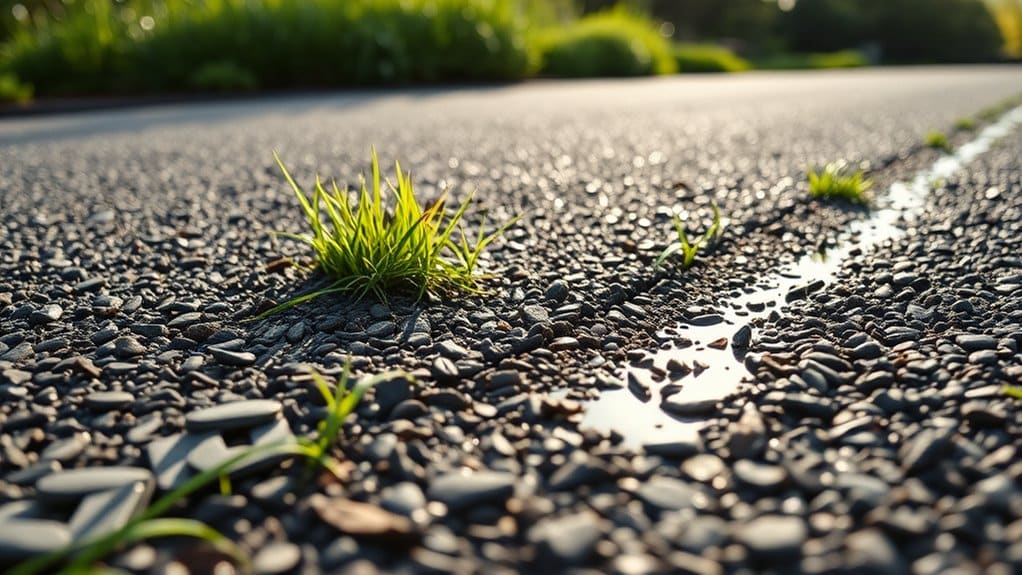
Regular checks ensure your resin-bound gravel driveway works properly, with drainage being a key factor to monitor.
Pour a bucket of water onto different sections and time how quickly it drains – it should disappear within 60 seconds. After heavy rain, look out for puddles, as these suggest possible drainage problems. Keep an eye on the small gaps between stones, making sure they’re not blocked with leaves or dirt.
Take photos every few months to spot any changes, particularly in areas that get heavy use. Your driveway should meet UK sustainable drainage (SUDS) standards, so check that water continues to filter through effectively.
These simple checks help prevent issues before they become serious problems. Simple yet regular monitoring keeps your driveway in top condition and helps avoid costly repairs down the line.
Frequently Asked Questions
Can I Install a Resin-Bound Driveway on a Steep Slope?
Yes, resin-bound driveways work well on steep slopes, though they require proper planning and skilled installation. The main challenges are ensuring solid ground preparation and effective water drainage. A qualified installer will add anti-slip additives and create suitable channels to manage water run-off, keeping your driveway safe and stable even in wet British weather.
How Does Temperature Affect the Installation of Resin-Bound Driveways?
Temperature plays a crucial role in resin-bound driveway installation. The ideal range is between 5°C and 25°C – anything outside these limits risks compromising the finish. Cold weather slows down curing times and affects resin viscosity, whilst excessive heat can cause the mixture to set too quickly, leading to an uneven surface. For best results, plan installation during mild weather conditions, typically spring or autumn in the UK, to ensure proper bonding and a durable finish that will last for years.
What Are the Color Options for Resin-Bound Gravel Driveways?
Resin-bound gravel driveways offer a range of colour choices to suit any property style. Natural stone colours like beige and grey provide classic kerb appeal, whilst amber and bronze tones add warmth to traditional homes. For contemporary properties, darker shades such as slate or charcoal create a smart, modern finish. Mix and match options allow for bespoke patterns, from simple borders to complete custom designs.
Are There Any Specific Tools Needed for Installation?
Essential tools required include a forced action mixer, screed sledge and specialist trowels. Using the proper equipment ensures thorough mixing, even spreading and a professional finish for your resin-bound surface.
How Long Does It Take for the Driveway to Cure Completely?
The driveway requires 36 to 48 hours to reach full strength. British weather conditions, particularly temperature and moisture levels, affect curing time – much like waiting for paint to dry in our climate. Plan to keep vehicles off the surface during this period to ensure proper hardening.
Conclusion
Proper drainage is vital for any resin-bound gravel driveway in the UK. A well-planned drainage system starts with a permeable sub-base, typically made of crushed stone, which allows rainwater to filter through naturally. The resin-bound surface itself should be at least 18mm thick and laid at a slight gradient (roughly 1:60) to direct water away from buildings.
For British weather, additional drainage features are worth considering. Simple channel drains at the driveway’s edge can handle heavy downpours, whilst soakaways help manage water build-up in clay-heavy soil common across Britain. These additions prove particularly useful during autumn when fallen leaves might block the surface’s natural drainage.
Regular checks of drainage channels, especially after storms, keep the system working effectively. Sweep away debris monthly and power-wash the surface yearly to maintain its permeability. A properly drained driveway will last years longer and prevent flooding issues common to British properties.
